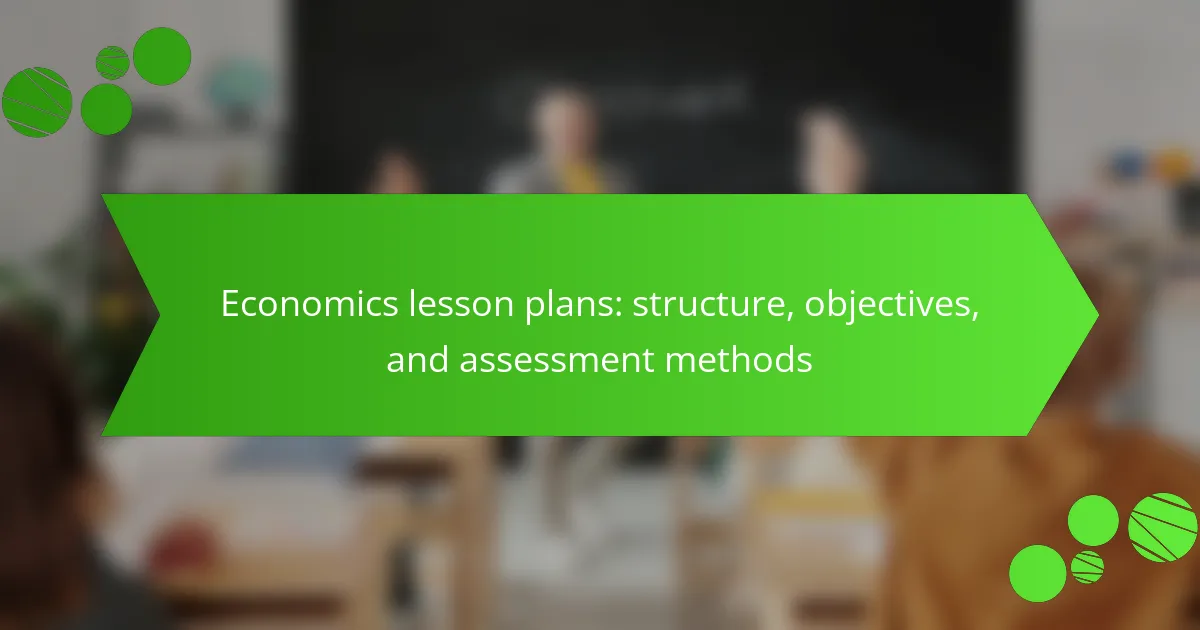Educational games designed for teaching economics encompass various formats, including simulations, board games, and interactive online platforms. Notable examples include simulations like “SimCity,” which focus on city management, and board games such as “Monopoly,” which illustrate property management and economic principles. Online resources like “EconEdLink” offer a range of games that cover diverse economic concepts. These educational games enhance student engagement by promoting interactive learning, and research indicates that game-based learning significantly improves retention of economic concepts while fostering critical thinking and decision-making skills essential in the field of economics. The article will explore the different formats of these educational games, their suitability for various age groups, and effective strategies for maximizing student engagement.

What are educational games for teaching economics?
Educational games for teaching economics include simulations, board games, and interactive online platforms. Simulations like “SimCity” allow players to manage a city’s economy. Board games such as “Monopoly” teach about property management and economic principles. Online platforms like “EconEdLink” provide resources and games for various economic concepts. These games engage students by making learning interactive and fun. Research shows that game-based learning improves retention of economic concepts. Games also encourage critical thinking and decision-making skills essential in economics.
How do educational games enhance the learning of economics?
Educational games enhance the learning of economics by providing interactive experiences that engage students. These games simulate real-world economic scenarios, allowing players to apply theoretical concepts. Players make decisions that affect outcomes, reinforcing the consequences of economic choices. Research shows that students retain information better when learning is active. A study by Hamari et al. (2016) found that gamification increases motivation and engagement in educational settings. Educational games also foster critical thinking and problem-solving skills. They encourage collaboration and communication among peers, enhancing social learning. Overall, educational games make economics more accessible and enjoyable for learners.
What specific economic concepts can be taught through games?
Games can teach various economic concepts effectively. These concepts include supply and demand, opportunity cost, and market equilibrium. Supply and demand illustrate how prices fluctuate based on availability and consumer interest. Opportunity cost helps players understand the trade-offs involved when making choices. Market equilibrium demonstrates how supply and demand interact to determine prices.
Games can also cover concepts like inflation, scarcity, and resource allocation. Inflation teaches players about the impact of rising prices on purchasing power. Scarcity emphasizes the limited nature of resources and the need for prioritization. Resource allocation involves making decisions on how to distribute limited resources efficiently.
Furthermore, games can introduce players to concepts of trade and comparative advantage. Trade shows the benefits of exchanging goods and services. Comparative advantage teaches players the advantages of specializing in certain areas to increase overall efficiency. These concepts are foundational in economic theory and can be effectively illustrated through interactive gameplay.
How do educational games cater to different learning styles?
Educational games cater to different learning styles by incorporating various interactive elements. They often include visual, auditory, and kinesthetic components. Visual learners benefit from graphics and animations. Auditory learners engage through sound effects and spoken instructions. Kinesthetic learners interact through hands-on activities and movement. Research shows that these diverse formats enhance retention and understanding. A study by Prensky (2001) highlights that games can improve learning outcomes across different styles. By appealing to multiple senses, educational games create a more inclusive learning environment.
What formats are available for educational games in economics?
Educational games in economics are available in various formats. These formats include board games, card games, digital games, simulations, and role-playing games. Board games often focus on economic principles and decision-making. Card games can introduce concepts like trade and resource management. Digital games utilize technology to engage players in economic scenarios. Simulations mimic real-world economic systems for hands-on learning. Role-playing games allow players to assume economic roles and make decisions. Each format provides unique ways to teach economic concepts effectively.
What are the differences between digital and board games in economics education?
Digital games in economics education utilize technology, while board games rely on physical components. Digital games often offer interactive experiences with instant feedback. This can enhance engagement and adaptability to different learning styles. Board games promote face-to-face interaction and teamwork among players. They also foster critical thinking through strategic decision-making in a tangible format. Research indicates that digital games can track progress and adapt difficulty levels based on player performance. In contrast, board games provide a structured environment that encourages discussion and negotiation. Both formats can effectively teach economic concepts, but they do so through different methods and experiences.
How do role-playing games contribute to understanding economic principles?
Role-playing games contribute to understanding economic principles by simulating real-world economic scenarios. Players make decisions that affect resource allocation, production, and consumption. This interactive format allows participants to experience the consequences of their economic choices. Research shows that role-playing games enhance critical thinking and problem-solving skills. For example, a study by D. B. Smith (2019) in the Journal of Economic Education found that students engaging in such games demonstrated improved comprehension of supply and demand concepts. Additionally, role-playing fosters collaboration and negotiation, key aspects of market interactions. Overall, these games provide a practical framework for applying economic theories in a controlled environment.
What age groups are most suitable for educational economics games?
Educational economics games are most suitable for children aged 8 to 18 years. This age range encompasses elementary, middle, and high school students. At age 8, children begin to grasp basic economic concepts. By middle school, students can handle more complex ideas like supply and demand. High school students are ready for advanced topics and real-world applications. Research shows that interactive games enhance engagement and understanding in these age groups. A study by the International Society for Technology in Education highlights the effectiveness of games in learning economics for ages 8-18.
Which games are appropriate for elementary school students?
Games appropriate for elementary school students include “Monopoly Junior,” “The Game of Life Junior,” and “Payday.” These games introduce basic economic concepts in a fun and engaging way. “Monopoly Junior” teaches money management and property ownership. “The Game of Life Junior” explores decision-making and consequences in a simplified life simulation. “Payday” focuses on budgeting and financial planning. Each game is designed for ages 5 and up, ensuring age-appropriate content and rules. They promote critical thinking and social skills while making learning enjoyable.
What educational games are best suited for high school learners?
Simulation games are best suited for high school learners. These games replicate real-world economic scenarios. They engage students by allowing them to make decisions and see outcomes. Examples include “Econland” and “SimCity.” “Econland” teaches resource management and economic principles. “SimCity” allows players to build and manage a city, incorporating economic strategies. Both games enhance critical thinking and problem-solving skills. Research indicates that simulation games improve understanding of complex concepts in economics.
How can engagement strategies enhance the effectiveness of educational games?
Engagement strategies can significantly enhance the effectiveness of educational games by increasing player motivation and participation. These strategies include incorporating elements such as rewards, challenges, and social interaction. For instance, game mechanics like points, badges, and leaderboards can motivate learners to progress. Research shows that games with competitive elements can lead to a 30% increase in user engagement. Additionally, collaborative activities within games foster teamwork and communication skills. This social aspect can improve learning outcomes by 25%, according to studies on cooperative learning. Overall, effective engagement strategies create a more immersive and impactful learning experience in educational games.
What techniques can be used to motivate students during gameplay?
Techniques to motivate students during gameplay include setting clear objectives and providing immediate feedback. Clear objectives help students understand what they need to achieve. Immediate feedback reinforces learning and keeps students engaged. Incorporating rewards can also enhance motivation. Rewards can be points, badges, or levels that recognize student achievements. Collaborative gameplay encourages teamwork and social interaction. This fosters a sense of community among students. Additionally, varying challenges maintains interest and prevents boredom. Tailoring difficulty levels to individual skill ensures all students remain challenged. Research shows that these techniques significantly improve student engagement and learning outcomes in educational games.
How does collaboration among students impact learning outcomes?
Collaboration among students positively impacts learning outcomes. It enhances critical thinking and problem-solving skills. When students work together, they share diverse perspectives. This diversity promotes deeper understanding of concepts. Research shows that collaborative learning increases retention rates. A study by Johnson and Johnson (1999) found that students in cooperative settings outperform those in competitive or individualistic environments. Additionally, collaboration fosters social skills and communication abilities. These skills are essential for real-world applications. Overall, collaborative learning leads to improved academic performance and engagement.
What are the challenges of using educational games in teaching economics?
Using educational games in teaching economics presents several challenges. One challenge is ensuring alignment with curriculum standards. Games must effectively cover economic concepts without deviating from educational goals. Another challenge is the varying levels of student engagement. Not all students respond positively to game-based learning. Technical issues can also arise, such as software glitches or lack of access to necessary technology. Additionally, measuring learning outcomes can be difficult. Traditional assessment methods may not adequately capture knowledge gained through gameplay. Finally, educators may lack training in integrating games into their teaching. This can hinder effective implementation and reduce the potential benefits of educational games.
How can educators overcome resistance to game-based learning?
Educators can overcome resistance to game-based learning by clearly demonstrating its educational benefits. Research shows that game-based learning increases engagement and retention of knowledge. Educators should provide evidence of improved student performance through case studies and statistics. Training sessions can help educators become familiar with game mechanics. Collaboration with colleagues can foster a supportive environment for implementing games. Additionally, addressing concerns about time management can alleviate resistance. Offering pilot programs allows educators to experience the benefits firsthand. Finally, involving students in the selection of games can increase buy-in and enthusiasm.
What resources are available for teachers to implement these games effectively?
Teachers can access various resources to implement educational games effectively. These resources include online platforms that offer game-based learning tools. Websites like Kahoot! and Quizizz provide interactive quizzes and games tailored for economics education. Additionally, teachers can find lesson plans and game guides on educational resource sites such as Teachers Pay Teachers. Professional development workshops also equip teachers with strategies for game implementation. Educational blogs and forums allow teachers to share experiences and best practices. Research studies highlight the effectiveness of game-based learning in improving student engagement and understanding of economics concepts.
What best practices should educators follow when integrating educational games into economics lessons?
Educators should align educational games with learning objectives in economics lessons. This ensures that the games reinforce key concepts such as supply and demand or market structures. Additionally, educators should select games that are age-appropriate to maintain student engagement. Research shows that games designed for specific age groups enhance understanding and retention.
Another best practice is to incorporate debriefing sessions after gameplay. These sessions allow students to reflect on their experiences and connect them to economic theories. Furthermore, educators should encourage collaboration among students during gameplay. This fosters teamwork and communication skills, which are essential in economics.
Finally, continuous assessment of the game’s effectiveness is crucial. Educators should gather feedback from students to refine their approach. Studies indicate that iterative improvements based on student input lead to better learning outcomes. By following these best practices, educators can effectively integrate educational games into economics lessons.
Educational games for teaching economics encompass various formats such as simulations, board games, and online platforms designed to engage students in interactive learning. The article explores how these games enhance understanding of economic concepts like supply and demand, opportunity cost, and market equilibrium, while catering to different learning styles. It also addresses age suitability, highlighting appropriate games for elementary and high school students, and discusses effective engagement strategies to motivate learners. Additionally, the article identifies challenges in implementing game-based learning and offers best practices for educators to integrate these tools into their economics lessons effectively.



